['Air Programs']
['Ozone Layer Protection']
01/16/2025
...
This appendix is based on the Air-Conditioning, Heating, and Refrigeration Institute Standard 700-2016, Specifications for Refrigerants.
Section 1. Purpose
1.1 Purpose. The purpose of this standard is to evaluate and accept/reject refrigerants regardless of source (i.e., new, reclaimed and/or repackaged) for use in new and existing refrigeration and air-conditioning products as required under 40 CFR part 82.
1.1.1 Intent. This standard is intended for the guidance of the industry including manufacturers, refrigerant reclaimers, repackagers, distributors, installers, servicemen, contractors and for consumers.
1.1.2 Review and Amendment. This standard is subject to review and amendment as the technology advances.
Section 2. Scope
2.1 Scope. This standard specifies acceptable levels of contaminants (purity requirements) for various fluorocarbon and other refrigerants regardless of source and lists acceptable test methods. These refrigerants are as referenced in the ANSI/ASHRAE Standard 34 with Addenda:
2.1.1 Single-Component Fluorocarbon Refrigerants: R-11, R-12, R-13, R-22, R-23, R-32, R-113, R-114, R-115, R-116, R-123, R-124, R-125, R-134a, R-141b, R-142b, R-143a, R-152a, R-218, R-227ea, R-236fa, R-245fa, R-1233zd(E), R-1234yf, R-1234ze(E);
2.1.2 Single Component Hydrocarbon Refrigerants: R-50, R-170, R-E170, R-290, R-600, R-600a, R-601, R-601a, R-610, R-1150, R-1270;
2.1.3 Carbon Dioxide Refrigerant: R-744;
2.1.4 Zeotropic Blend Refrigerants: R-401A, R-401B, R-402A, R-402B, R-403A, R-403B, R-404A, R-405A, R-406A, R-407A, R-407B, R-407C, R-407D, R-407E, R-407F, R-408A, R-409A, R-409B, R-410A, R-410B, R-411A, R-411B, R-412A, R-413A, R-414A, R-414B, R-415A, R-415B, R-416A, R-417A, R-417B, R-417C, R-418A, R-419A, R-419B, R-420A, R-421A, R-421B, R-422A, R-422B, R-422C, R-422D, R-422E, R-423A, R-424A, R-425A, R-426A, R-427A, R-428A, R-429A, R-430A, R-431A, R-434A, R-435A, R-437A, R-438A, R-439A, R-440A, R-442A, R-444A, R-444B, R-445A, R-446A, R-447A, R-448A, R-449A, R-450A;
2.1.5 Zeotropic Hydrocarbon Blend Refrigerants: R-432A, R-433A, R-433B, R-433C, R-436A, R-436B, R-441A, R-443A; and
2.1.6 Azeotropic Blend Refrigerants: R-500, R-502, R-503, R-507A, R-508A, R-508B, R-509A, R-510A, R-511A, and R-512A.
Section 3. Definitions
3.1 Definitions. All terms in this appendix will follow the definitions in §82.152 unless otherwise defined in this appendix.
3.2 Shall, Should, Recommended, or It Is Recommended shall be interpreted as follows:
3.2.1 Shall. Where “shall” or “shall not” is used for a provision specified, that provision is mandatory if compliance with this appendix is claimed.
3.2.2 Should, Recommended, or It is Recommended is used to indicate provisions which are not mandatory but which are desirable as good practice.
Section 4. Characterization of Refrigerants and Contaminants
4.1 Characterization. Characterization of single component fluorocarbon (Table 1A) and zeotropic/azeotropic blend (Table 2A/3) refrigerants and contaminants are listed in the following general classifications:
4.1.1 Isomer content (see Table 1A)
4.1.2 Air and other non-condensables (see Tables 1A, 2A, 3)
4.1.3 Water (see Tables 1A, 2A, 3)
4.1.4 All other volatile impurities (see Tables 1A, 2A, 3)
4.1.5 High boiling residue (see Tables 1A, 2A, 3)
4.1.6 Halogenated unsaturated volatile impurities (see Table 1A)
4.1.7 Particulates/solids (see Tables 1A, 2A, 3)
4.1.8 Acidity (see Tables 1A, 2A, 3)
4.1.9 Chloride (see Tables 1A, 2A, 3)
4.2 Hydrocarbon Characterization. Characterization of hydrocarbon refrigerants (Tables 1B and 2B) and contaminants are listed in the following general classifications:
4.2.1 Nominal composition
4.2.2 Other allowable impurities
4.2.3 Air and other non-condensables
4.2.4 Sulfur odor
4.2.5 High boiling residue
4.2.6 Particulates/solids
4.2.7 Acidity
4.2.8 Water
4.2.9 All other volatile impurities
4.2.10 Total C3, C4, and C5 polyolefins
4.3 Carbon Dioxide Characterization. Characterization of carbon dioxide (Table 1C) and its contaminants are listed in the following general classifications:
4.3.1 Purity
4.3.2 Air and other non-condensables
4.3.3 Water
4.3.4 High boiling residue
4.3.5 Particulates/solids
Section 5. Sampling and Summary of Test Procedures
5.1 Referee Test. The referee test methods for the various contaminants are summarized in the following paragraphs. Detailed test procedures are included in 2008 Appendix C to AHRI Standard 700-2014 (incorporated by reference, see §82.168). If alternative test methods are employed, the user must be able to demonstrate that they produce results at least equivalent to the specified referee test method.
5.2 Refrigerant Sampling
5.2.1 Sampling Precautions. Special precautions should be taken to ensure that representative samples are obtained for analysis. Sampling shall be done by qualified personnel following accepted sampling and safety procedures. Refrigerants with critical temperatures near or below ambient temperature cannot be reliably sampled for both liquid and vapor phase without special handling.
Note: Flammable refrigerants which are ASHRAE 34 class 2L, 2, or 3 present additional safety challenges and require additional measures for sampling safety procedures compared to nonflammable halocarbons documented in this standard.
5.2.2 Cylinder Preparation. Place a clean, empty sample cylinder with the valve open in an oven at 110°C (230°F) for one hour. Remove it from the oven while hot, immediately connect it to an evacuation system and evacuate to less than 56 kPa. Close the valve and allow it to cool. Weigh the empty cylinder.
5.2.3 Vapor Phase Sampling. A vapor phase sample shall be obtained for determining the non-condensables. The source temperature shall be measured and recorded at the time the sample is taken.
5.2.3.1 Special Handling for Low Critical Temperature Refrigerant. A vapor phase sample is required to determine non-condensables and volatile impurities, including other refrigerants. The vapor phase sample is obtained by regulating the sample container temperature to 5 K or more above the refrigerant critical temperature.
5.2.3.2 Handling for Liquid Refrigerants with Boiling Points Near or Above Room Temperature. Since R-11, R-113, R-123, R-141b, R-245fa, and R-1233zd(E) have normal boiling points near or above room temperature, non-condensable determination is not required for these refrigerants.
Note: Non-condensable gases, if present, will concentrate in the vapor phase of the refrigerant; care must be exercised to eliminate introduction of either air or liquid phase refrigerant during the sample transfer.
5.2.4 Liquid Phase Sampling. A liquid phase sample is required for all tests listed in this standard except the test for non-condensables.
5.2.4.1 Liquid Sampling. Accurate analysis requires that the sample cylinder, at ambient temperature, be filled to at least 60 percent by volume; however, under no circumstances should the cylinder be filled to more than 80 percent by volume. This can be accomplished by weighing the empty cylinder and then the cylinder with refrigerant. When the desired amount of refrigerant has been collected, close the valve(s) and immediately disconnect the sample cylinder.
Note: Care should be taken to ensure that all connections and transfer lines are dry and evacuated to avoid contaminating the sample.
Note: Low critical temperature refrigerants can have extremely high pressure and the sampling vessel, all connections, and transfer lines must be designed to handle high pressures.
5.2.4.2 Special Handling for Low Critical Temperature Refrigerant. A liquid phase sample is required for all testing except volatile impurities, including other refrigerants. The liquid phase sample is obtained by regulating the sample cylinder temperature to 2°C below the critical temperature of the refrigerant.
Note: If free water is present in the sample, cooling to below 0°C may result in the formation of ice. Clathrates may form at temperatures above 0°C with some fluorocarbon refrigerants.
5.2.4.3 Record Weight. Check the sample cylinder for leaks and record the gross weight.
5.3 Refrigerant Identification. The required method shall be gas chromatography (GC) as described in 2008 Appendix C to AHRI Standard 700-2014 (incorporated by reference, see §82.168) with the corresponding gas chromatogram figures as illustrated in 2012 Appendix D to AHRI Standard 700-2014 (incorporated by reference, see §82.168). The chromatogram of the sample shall be compared to known standards.
5.3.2 Alternative Method. Determination of the boiling point and boiling point range is an acceptable alternative test method which can be used to characterize refrigerants. The test method shall be that described in section 4.4.3 of BB-F-1421B (incorporated by reference, see §82.168).
5.3.3 Required Values. The required values for boiling point and boiling point range are given in Table 1A, Physical Properties of Single Component Refrigerants; Table 1B, Physical Properties of Zeotropic Blends (400 Series Refrigerants); and Table 1C, Physical Properties of Azeotropic Blends (500 Series Refrigerants).
5.4 Water Content.
5.4.1 Method. The Coulometric Karl Fischer Titration shall be the primary test method for determining the water content of refrigerants. This method is described in 2008 Appendix C to AHRI Standard 700-2014 (incorporated by reference, see §82.168). This method can be used for refrigerants that are either a liquid or a gas at room temperature. For all refrigerants, the sample for water analysis shall be taken from the liquid phase of the container to be tested.
5.4.2 Limits. The value for water content shall be expressed in parts per million (ppm) by weight and shall not exceed the maximum specified in Tables 1A, 1B, 1C, 2A, 2B, and 3.
5.5 Conductivity. (Alternative to chloride and acidity tests).
5.5.1 Method. A refrigerant may be tested for conductivity as an indication of the presence of acids, metal chlorides, and any compound that ionizes in water. This alternative procedure is intended for use with new or reclaimed refrigerants, however, significant amounts of oil can interfere with the test results.
5.5.2 Limits. The value for conductivity shall be converted to and expressed in ppm by weight calculated as HCl and shall be compared with the maximum acidity value specified (see in Tables 1A, 1B, 1C, 2A, 2B, and 3). If the conductivity is above this amount, then the chloride and acidity tests shall be conducted. If the conductivity is not greater than this amount, then the chloride and acidity tests may be omitted.
5.6 Chloride. The refrigerant shall be tested for chloride as an indication of the presence of hydrochloric acid and/or metal chlorides. The referee procedure is intended for use with new or reclaimed halogenated refrigerants; however, high boiling residue in excess of the amounts in Tables 1A, 1B, 1C, 2A, 2B, and 3 can interfere with the test results.
5.6.1 Method. The test method shall be that described in 2008 Appendix C to AHRI Standard 700-2014 (incorporated by reference, see §82.168). The test will show noticeable turbidity at chloride levels of about 3 ppm or greater by weight.
5.5.2 Limits. The results of the test shall not exhibit any sign of turbidity. Report the results as “pass” or “fail.”
5.7 Acidity.
5.7.1 Method. The acidity test uses the titration principle to detect any compound that is soluble in water and ionizes as an acid. The test method shall be that described in 2008 Appendix C to AHRI Standard 700-2014 (incorporated by reference, see §82.168). This test may not be suitable for determination of high molecular weight organic acids; however these acids will be found in the high boiling residue test outlined in Section 5.8. The test requires a 50 to 60 gram sample and has a detection limit of 0.1 ppm by weight calculated as HCl.
5.7.2 Limits. The value for acidity shall be expressed in ppm by weight as HCl and shall not exceed the limits in Tables 1A, 1B, 2A, 2B, and 3.
5.8 High Boiling Residue.
5.8.1 Method. High boiling residue shall be determined by either volume or weight. The volume method measures the residue from a standard volume of refrigerant after evaporation. The gravimetric method is described in 2008 Appendix C to AHRI Standard 700-2014 (incorporated by reference, see §82.168). Oils and/or organic acids will be captured by these methods.
5.8.2 Limits. The value for high boiling residue shall be expressed as a percentage by volume or weight and shall not exceed the maximum percent specified in Tables 1A, 1B, 1C, 2A, 2B, and 3.
5.9 Particulates and Solids.
5.9.1 Method. A measured amount of sample shall be placed in a Goetz bulb under controlled temperature conditions. The particulates/solids shall be determined by visual examination of the Goetz bulb prior to the evaporation of refrigerant. For details of this test method, refer to Part 3 of 2008 Appendix C to AHRI Standard 700-2014 (incorporated by reference, see §82.168).
Note: R-744 will partially sublimate when measuring a known amount of liquid sample into the dry Goetz bulb and the solid R-744 will interfere with the visual examination of particulates/solids. Determining the particulates/solids shall be completed by visual examination of the Goetz bulb after the evaporation of the refrigerant.
5.9.2 Limits. Visual presence of dirt, rust, or other particulate contamination is reported as “fail.”
5.10 Non-Condensables.
5.10.1 Method. A vapor phase sample shall be used for determination of non-condensables. Non-condensable gases consist primarily of air accumulated in the vapor phase of refrigerants where the solubility of air in the refrigerant liquid phase is extremely low and air is not significant as a liquid phase contaminant. The presence of non-condensable gases may reflect poor quality control in transferring refrigerants to storage tanks and cylinders.
The test method shall be gas chromatography with a thermal conductivity detector as described in 2008 Appendix C to AHRI Standard 700-2014 (incorporated by reference, see §82.168).
5.10.2 Limits. The maximum level of non-condensables in the vapor phase of a test sample shall not exceed the maximum at 25°C as shown in Tables 1A, 1B, 1C, 2A, 2B, and 3.
5.11 All Other Volatile Impurities and/or Other Refrigerants.
5.11.1 Method. The amount of volatile impurities including other refrigerants in the subject refrigerant shall be determined by gas chromatography as described in 2008 Appendix C to AHRI Standard 700-2014 (incorporated by reference, see §82.168).
5.11.2 Limits. The test sample shall not contain more than 0.5 percent by weight of volatile impurities including other refrigerants as shown in Tables 1A, 1B, 1C, 2A, 2B and 3.
5.12 Total C 3 , C 4 and C 5 Polyolefins in Hydrocarbon Refrigerants.
5.12.1 Method. The amount of polyolefin impurities in the hydrocarbon shall be determined by gas chromatography as described in GPA Standard 2177-13 (incorporated by reference, see §82.168).
5.12.2 Limits. The test sample shall not contain more than 0.05 percent by weight in the hydrocarbon sample as shown in Tables 1B and 2B. Report the results as “pass” or “fail.”
5.13 Sulfur Odor in Hydrocarbon Refrigerants.
5.13.1 Method. The amount of sulfur containing compounds or other compounds with an odor shall be determined by ASTM D1296-01 (Reapproved 2012) (incorporated by reference, see §82.168).
5.13.2 Limits. The test sample paper shall not emit a residual sulfur odor as shown in Tables 1B and 2B.
Section 6. Reporting Procedure
6.1 Reporting Procedure. The source (manufacturer, reclaimer, or repackager) of the packaged refrigerant shall be identified. The refrigerant shall be identified by its accepted refrigerant number and/or its chemical name. Maximum allowable levels of contaminants are shown in Tables 1A, 1B, 1C, 2A, 2B, and 3. Test results shall be tabulated in a similar manner.
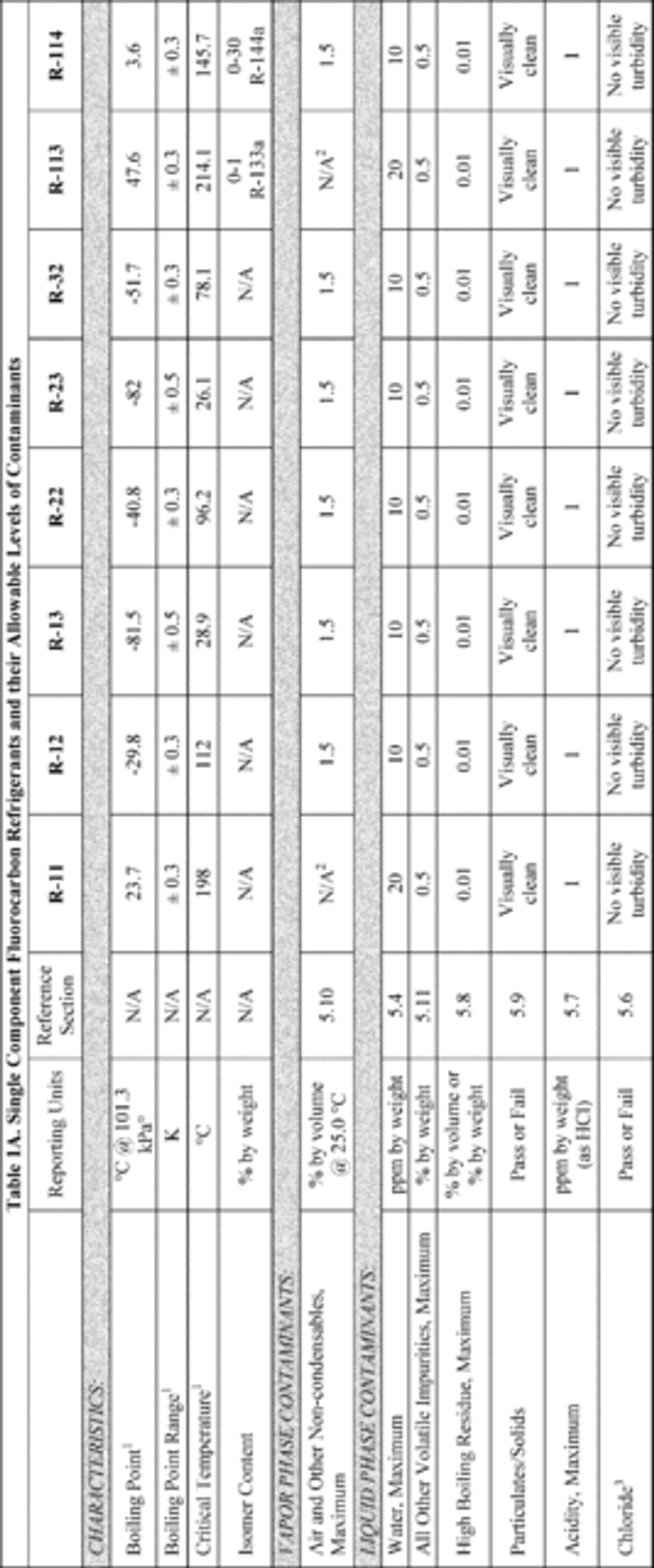
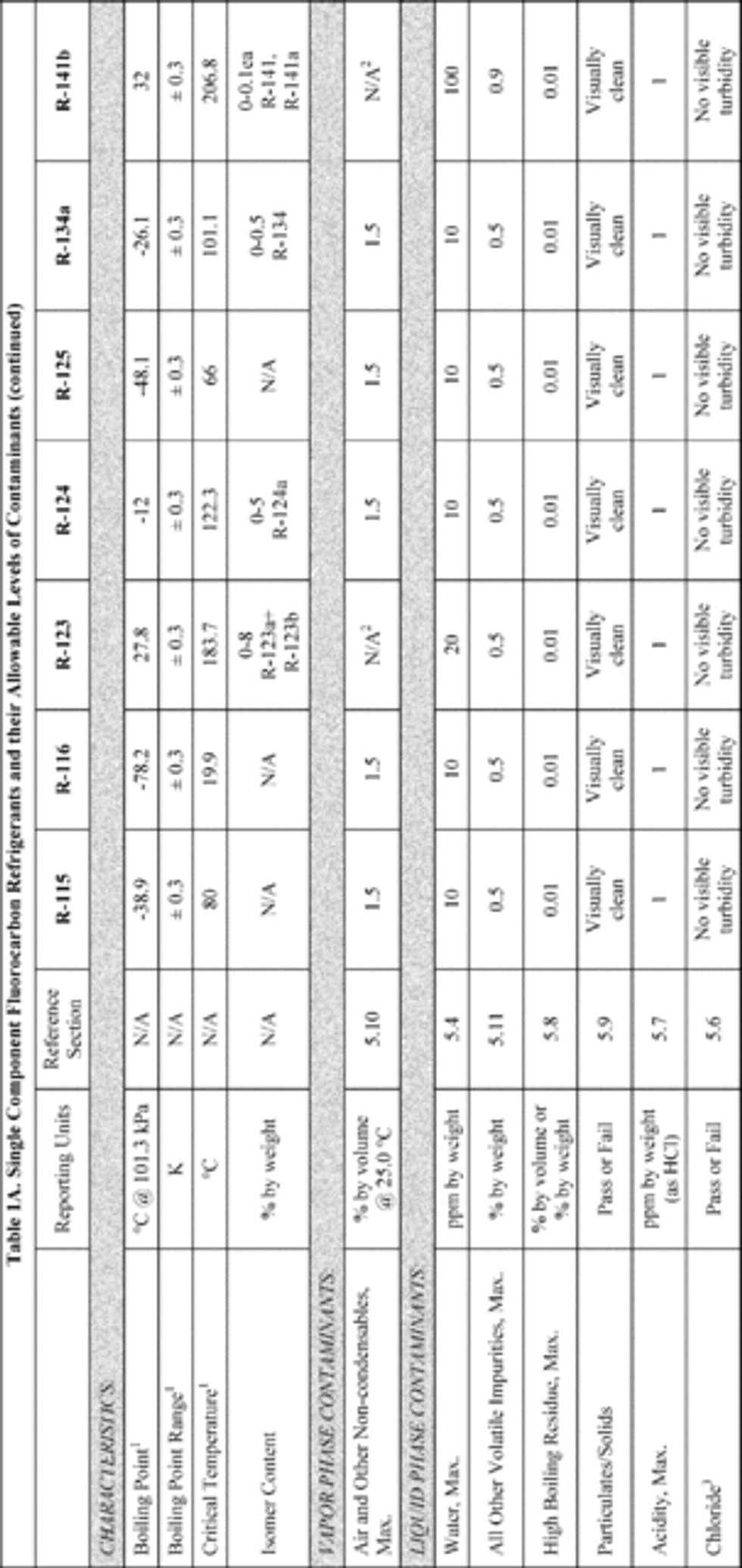
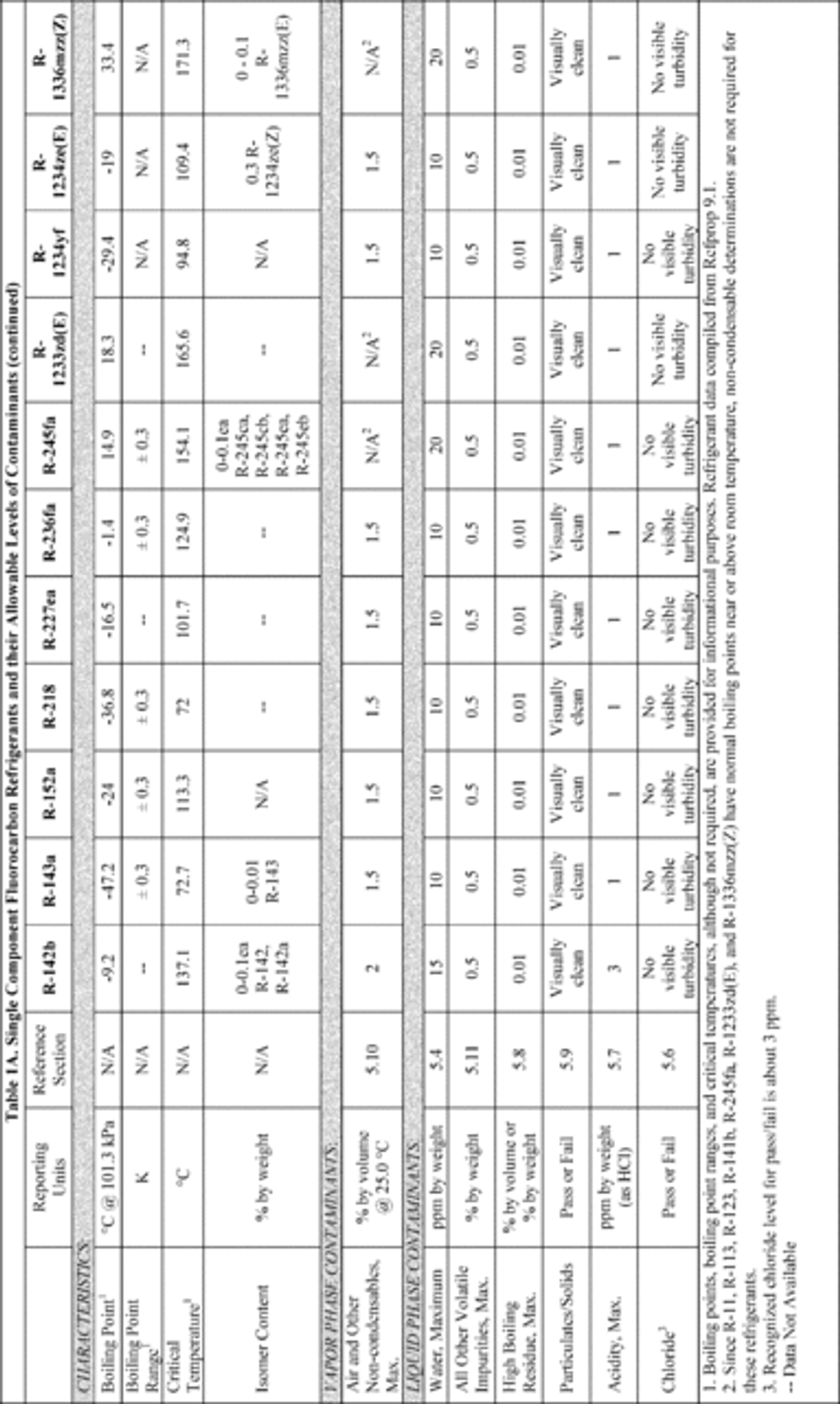
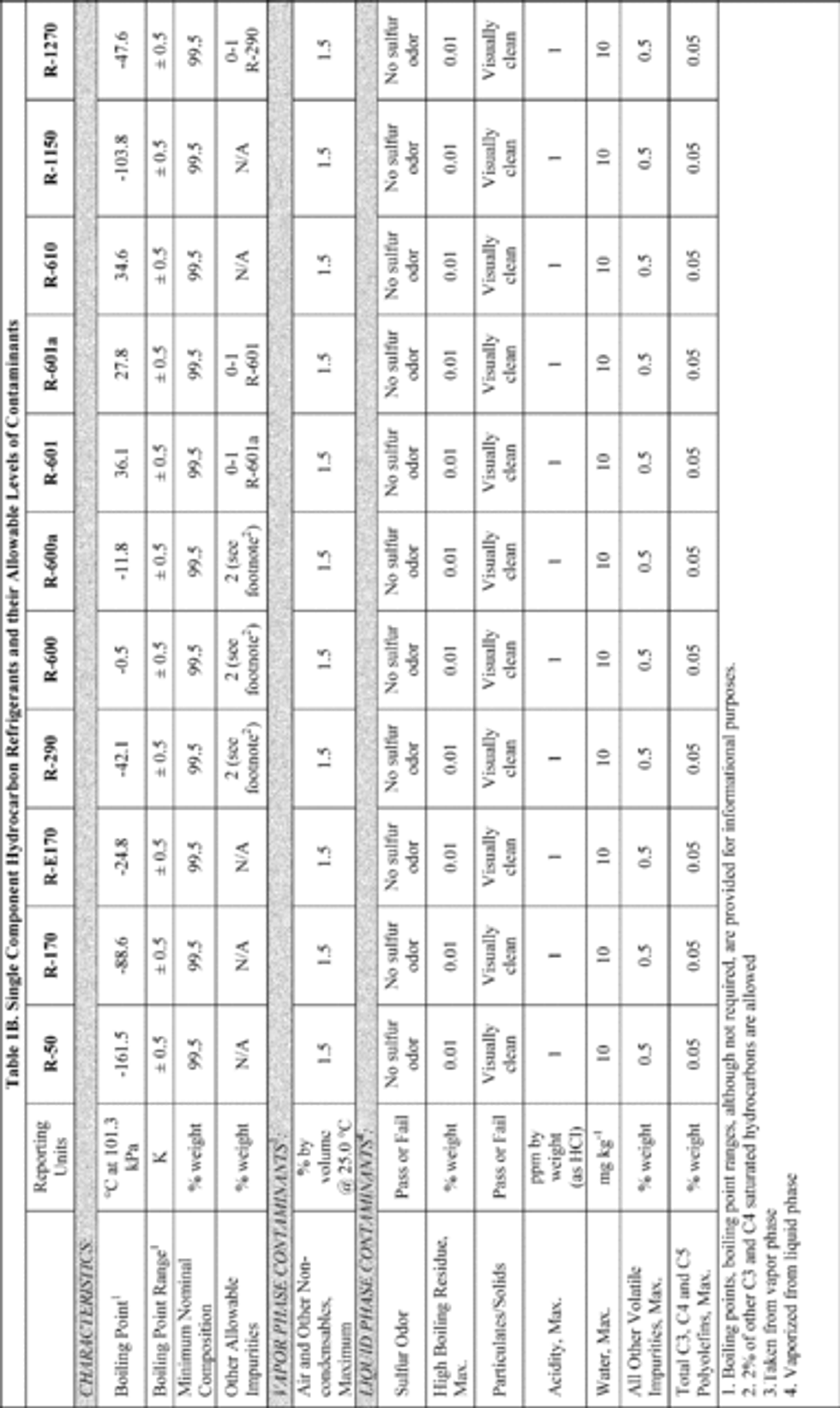
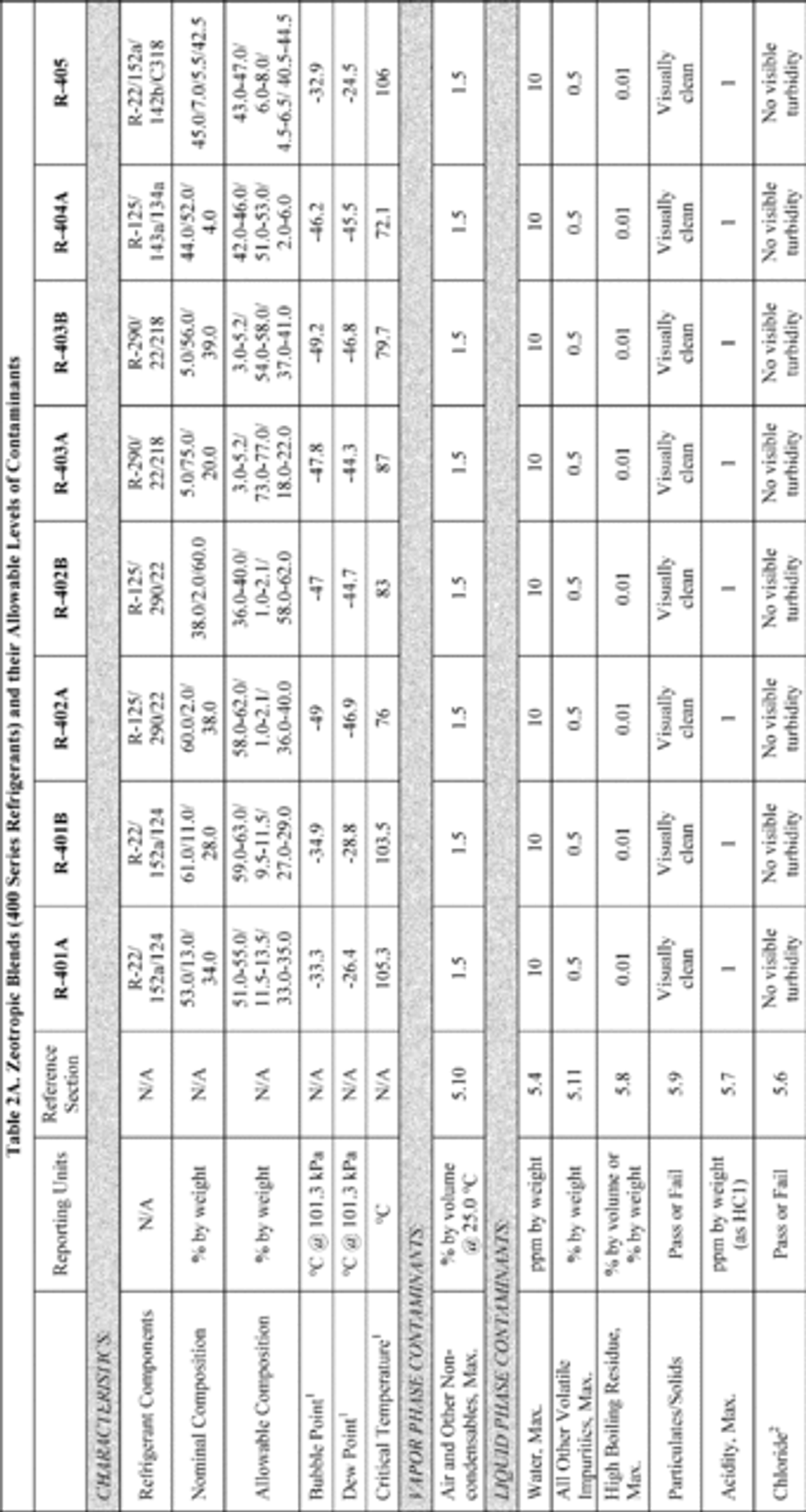
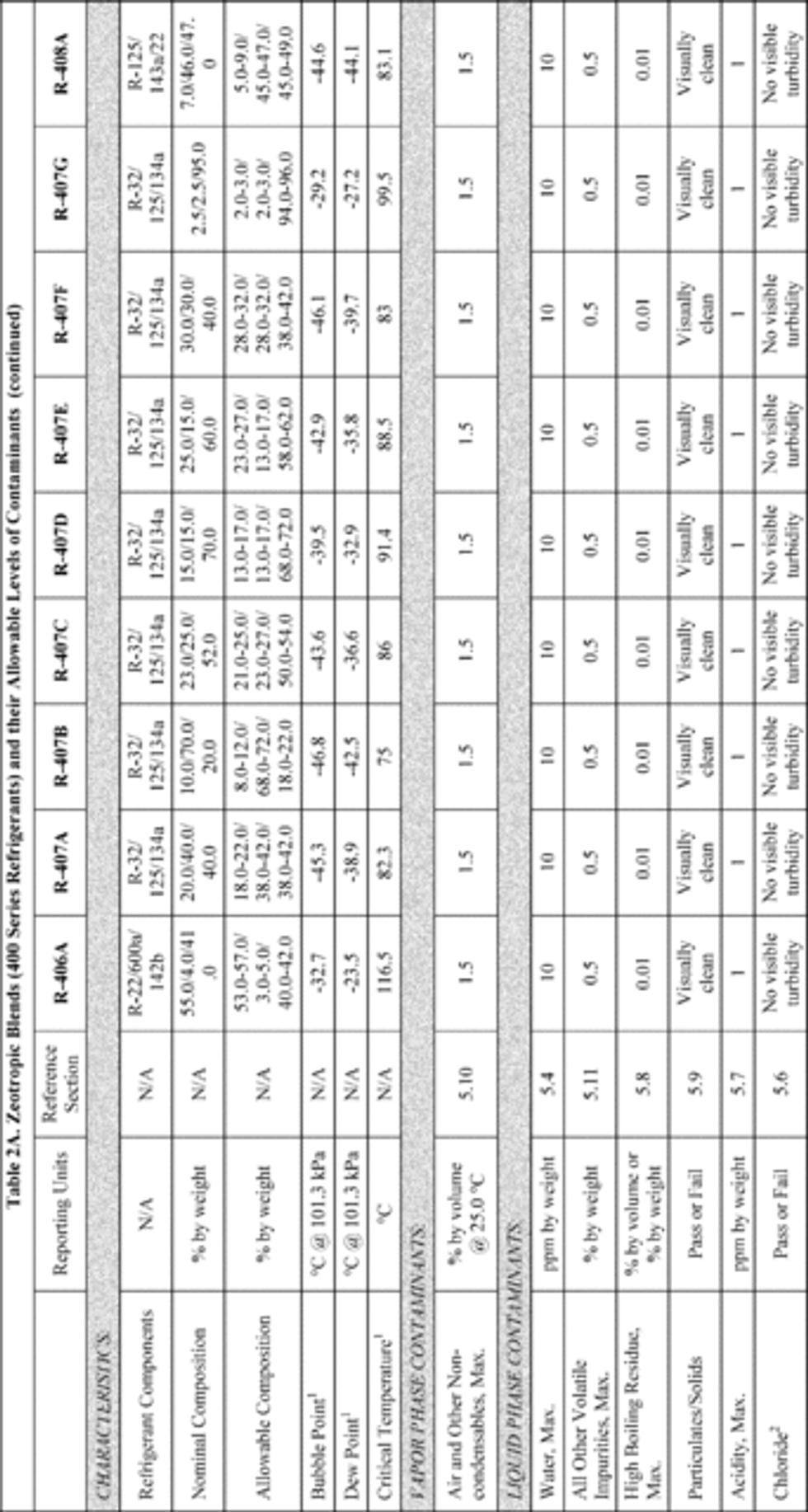
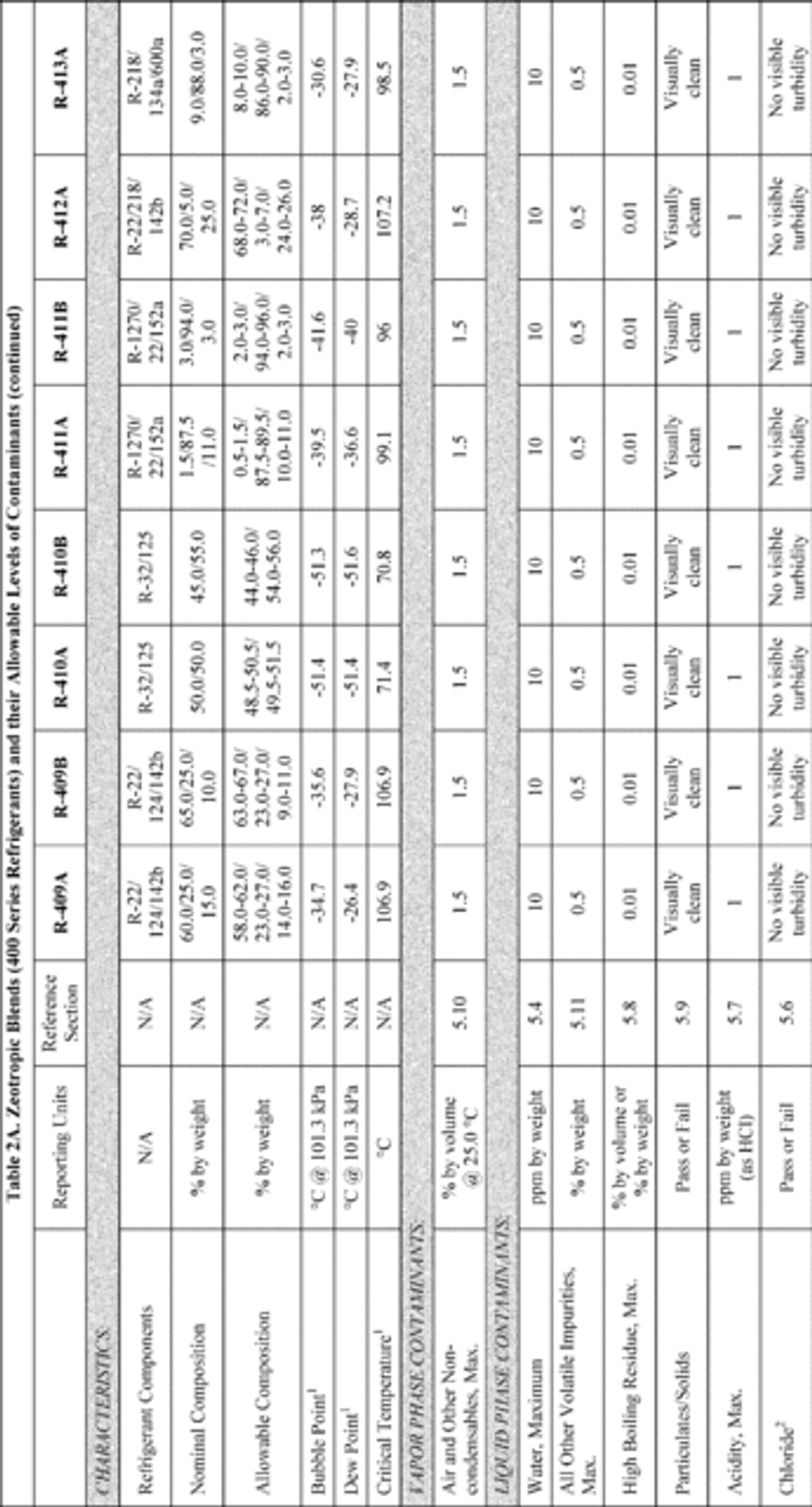
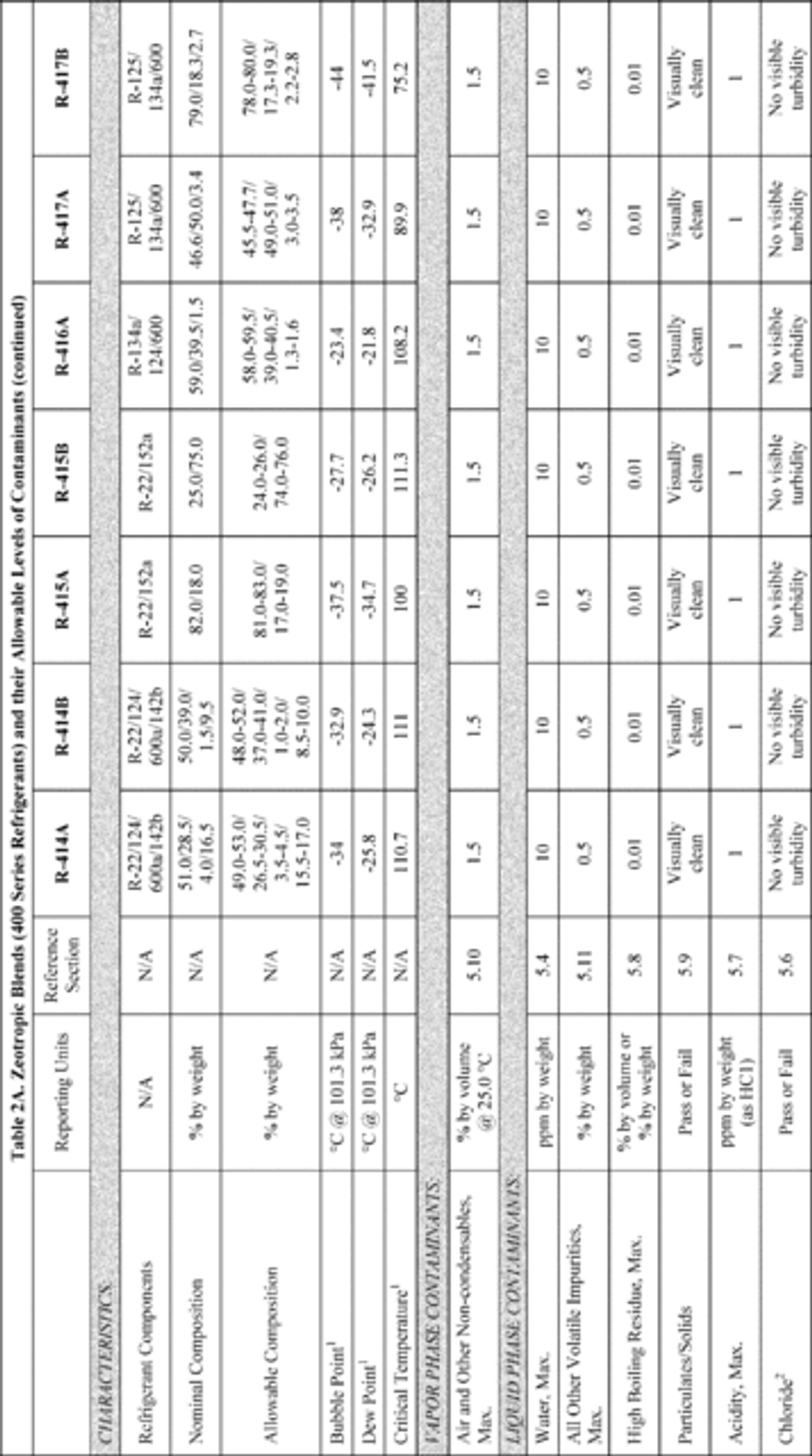
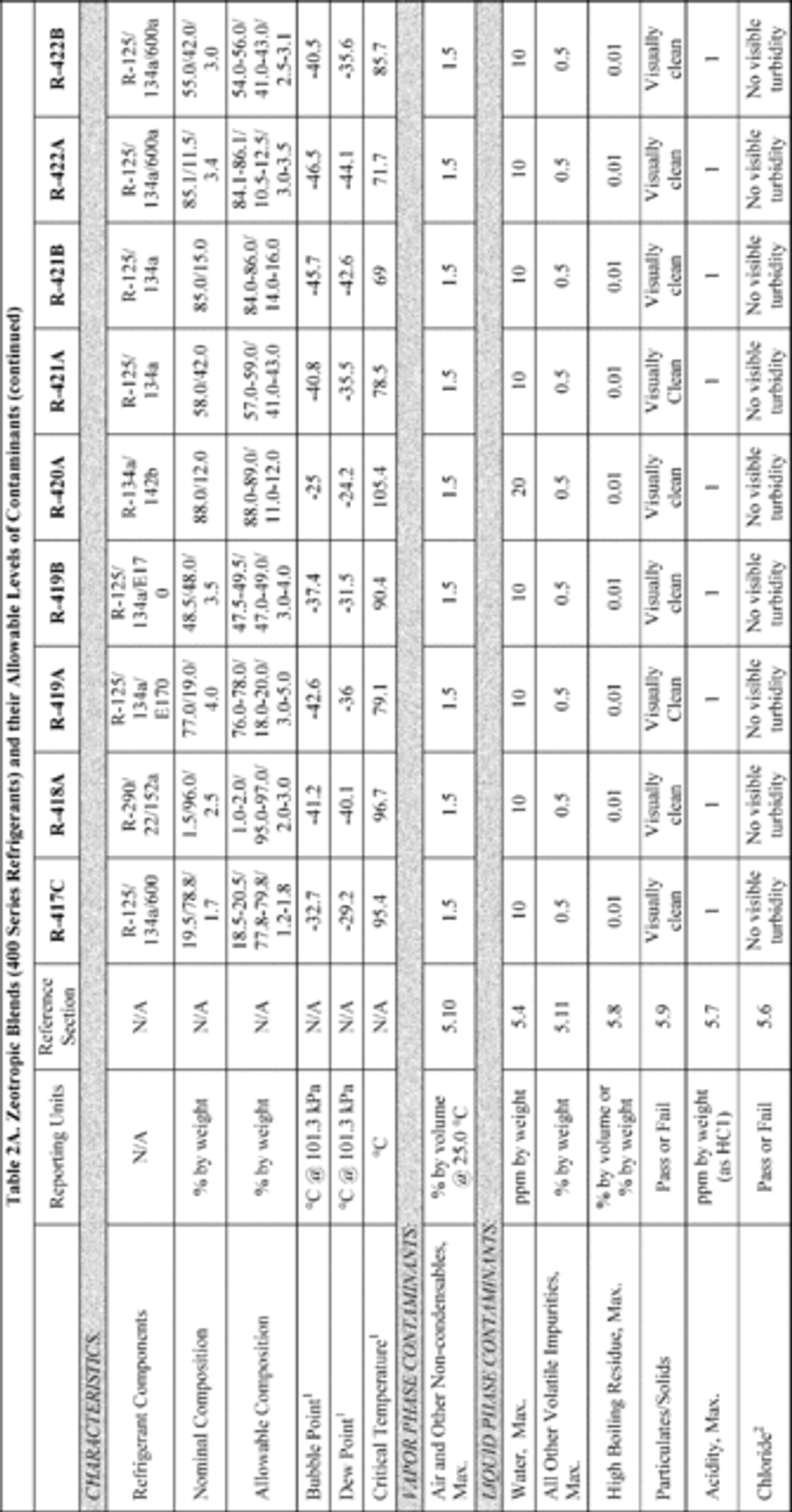
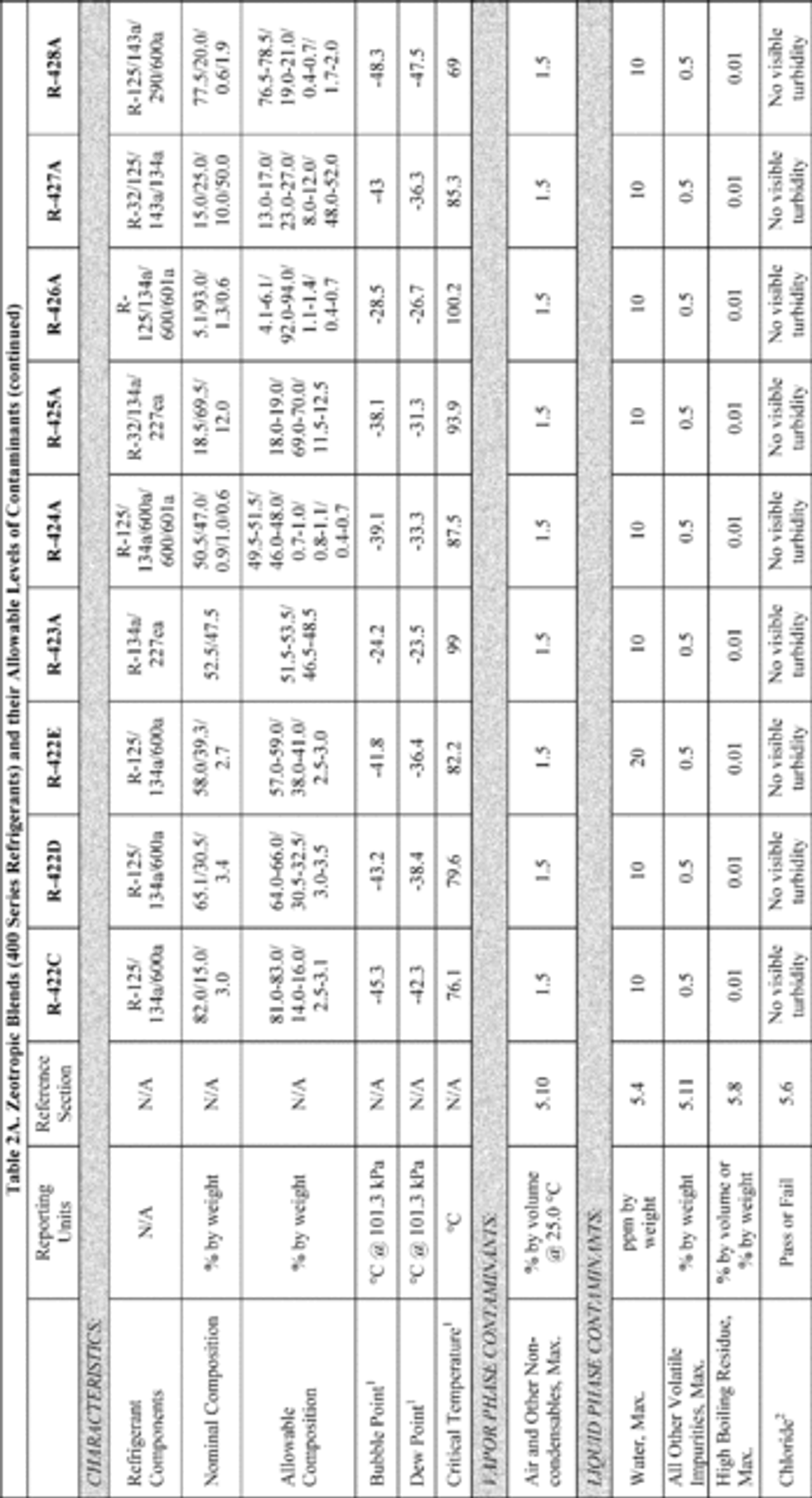

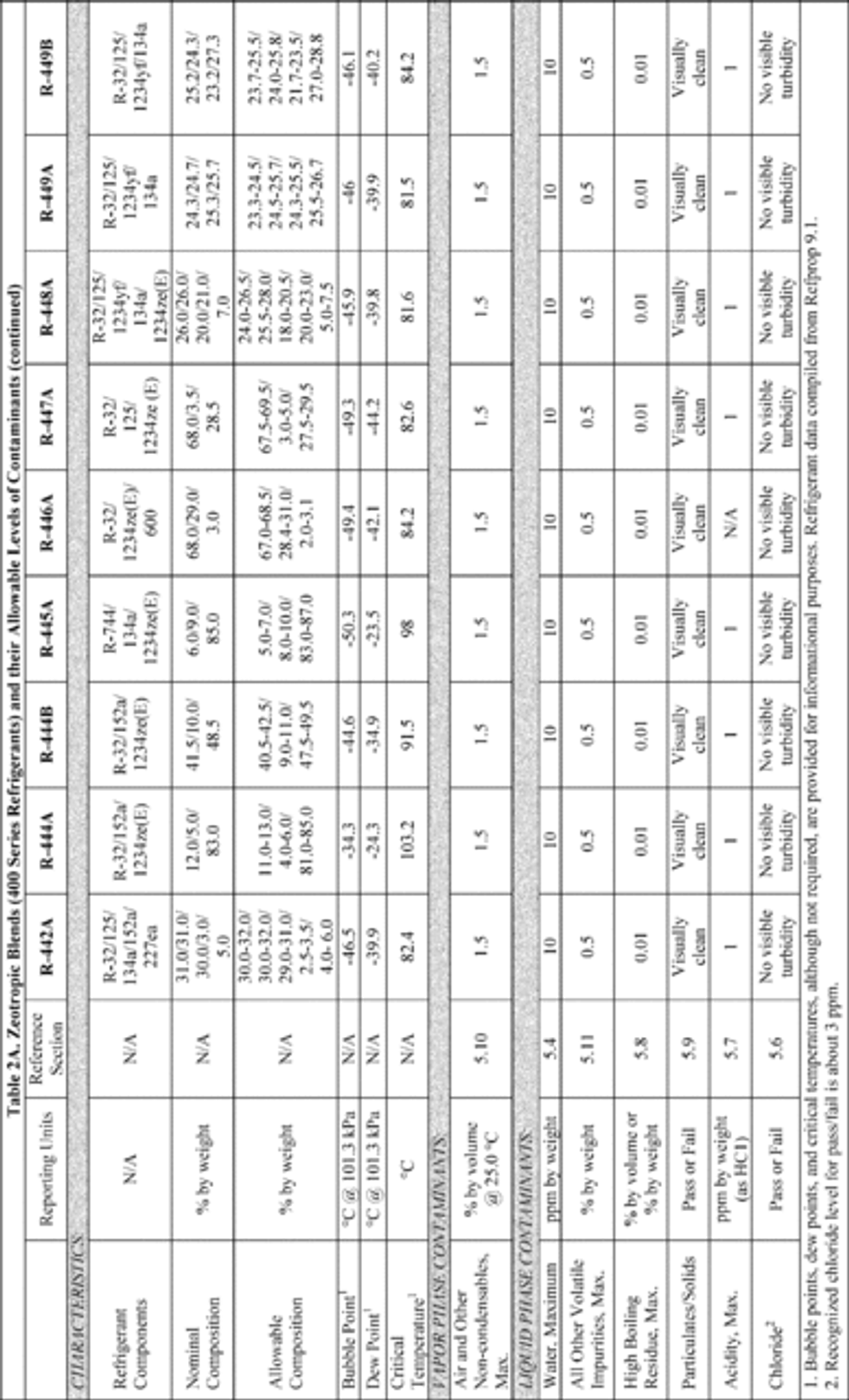
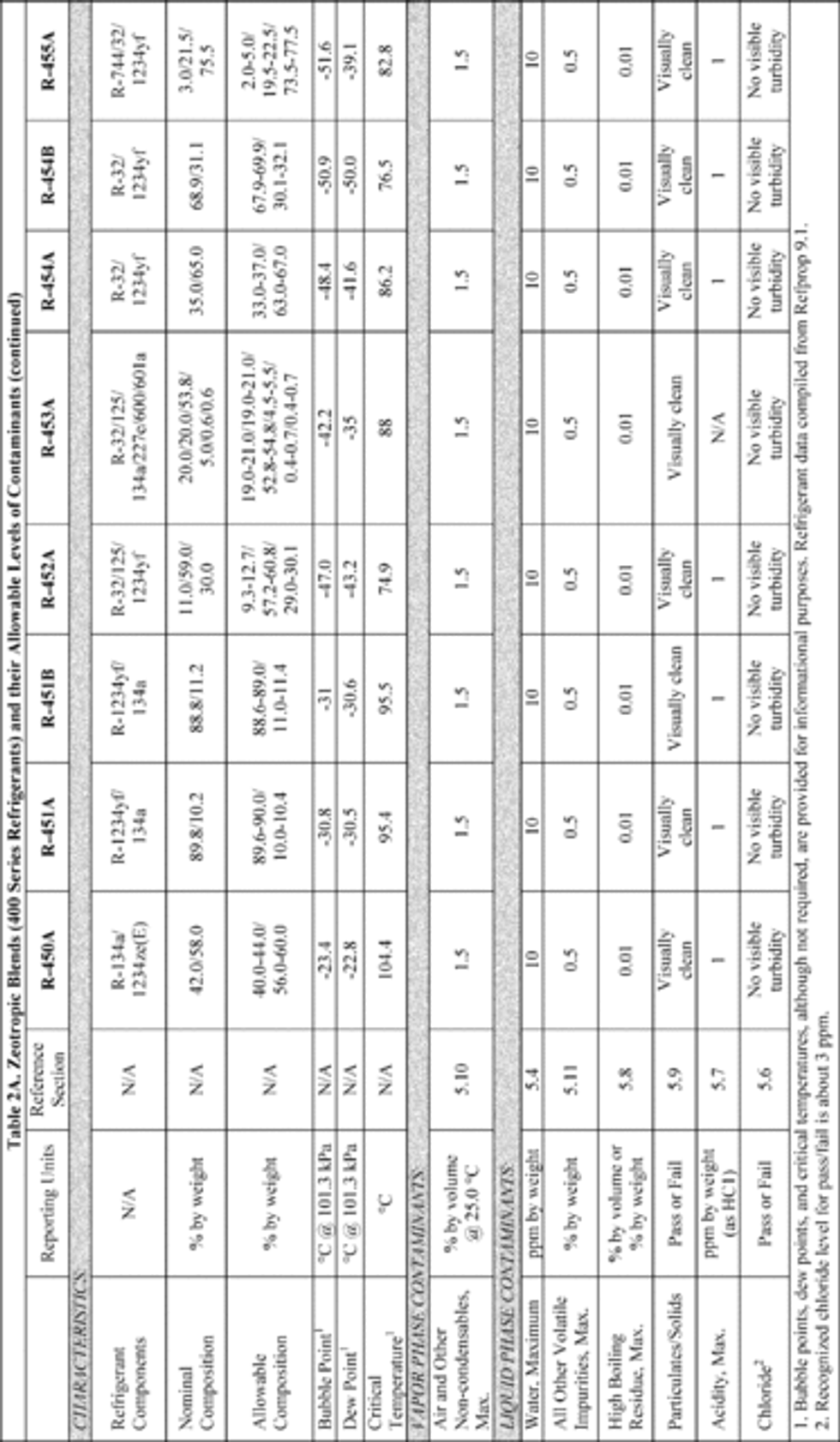
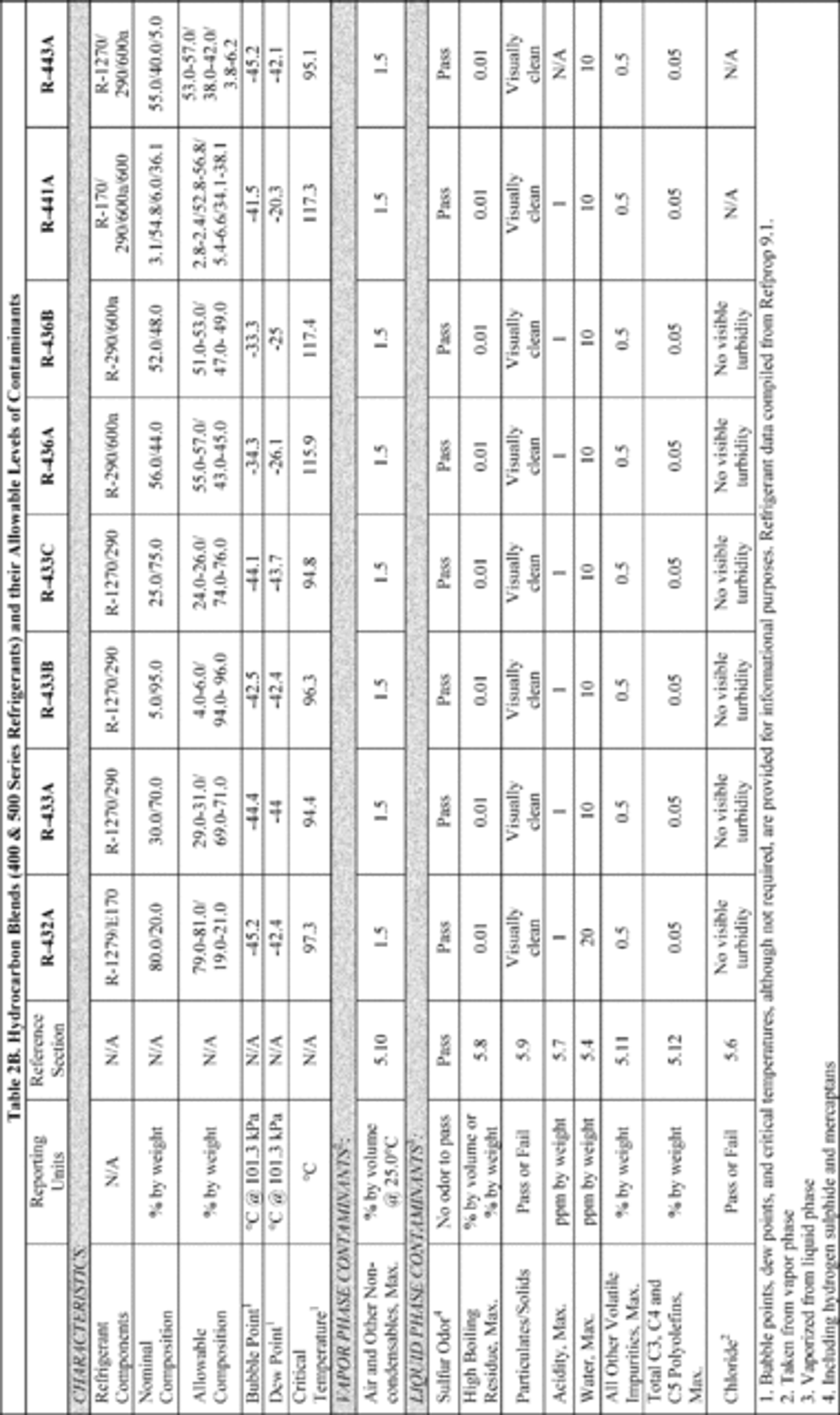
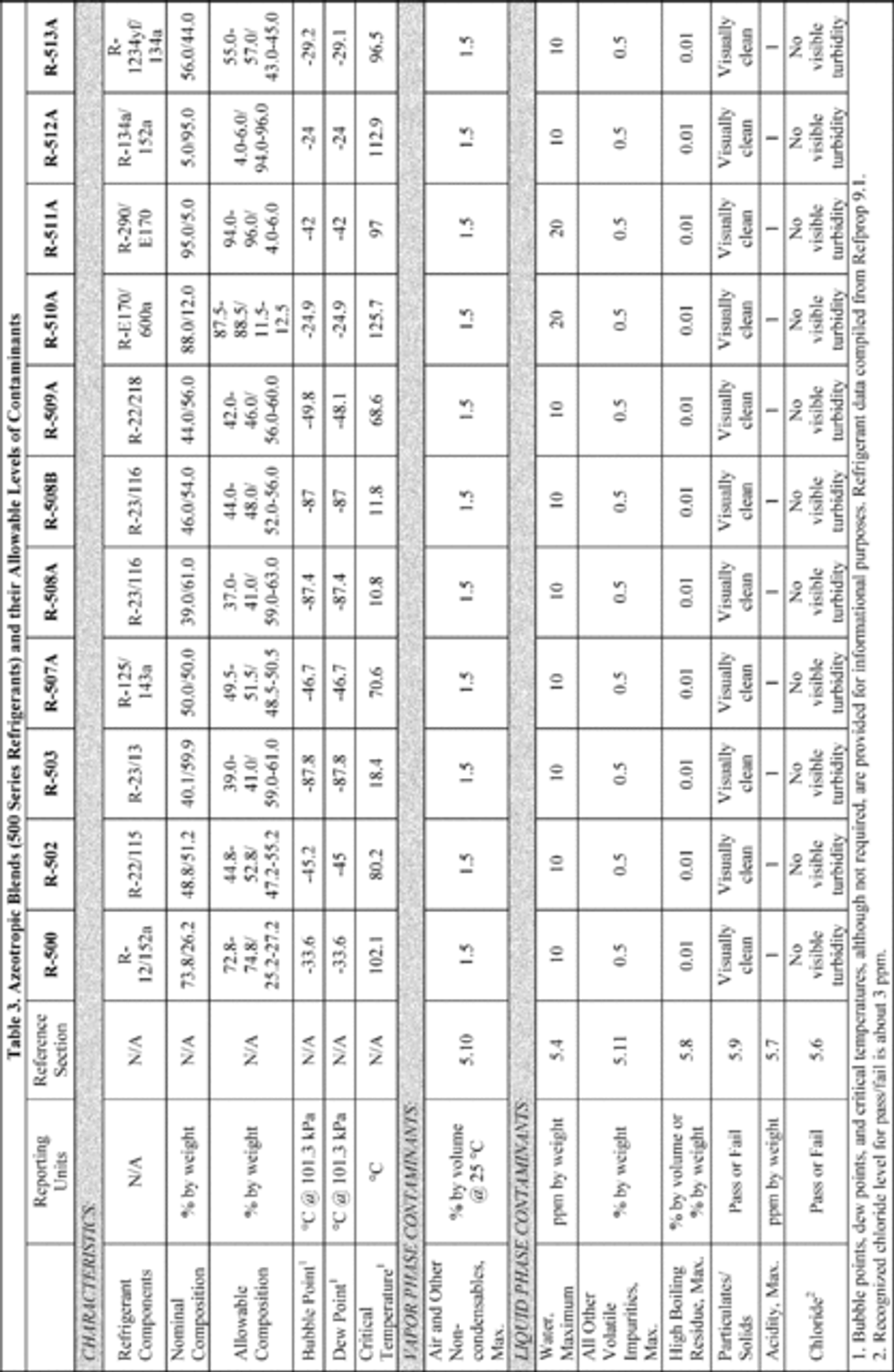
Section 7.0 References - Normative
Listed here are all standards, handbooks, and other publications essential to the formation and implementation of the standard. All references in this appendix are considered as part of this standard.
ANSI/ASHRAE Standard 34-2013, Designation and Safety Classification of Refrigerants, with Addenda, American National Standards Institute/American Society of Heating, Refrigerating, and Air-Conditioning Engineers.
2008 Appendix C to AHRI Standard 700-2014, 2008 Appendix C for Analytical Procedures for AHRI Standard 700-2014 - Normative, copyright 2008 (incorporated by reference, see § 82.168).
ASTM D1296-01 (Reapproved 2012), Standard Test Method for Odor of Volatile Solvents and Diluents, approved July 1, 2012, (incorporated by reference, see § 82.168).
BB-F-1421B, Federal Specification for “Fluorocarbon Refrigerants,” dated March 5, 1982, (incorporated by reference, see § 82.168).
GPA Standard 2177-13, Analysis of Natural Gas Liquid Mixtures Containing Nitrogen and Carbon Dioxide by Gas Chromatography, Revised, copyright 2013, (incorporated by reference, see § 82.168).
REFPROP Reference Fluid Thermodynamic and Transport Properties NIST Standard Reference Database 23 version 9.1, 2013, U.S. Department of Commerce, Technology Administration, National Institute of Standards and Technology.
Section 8.0 References - Informative
Listed here are standards, handbooks, and other publications which may provide useful information and background but are not considered essential.
2012 Appendix D to AHRI Standard 700-2014, 2012 Appendix D for Gas Chromatograms for AHRI Standard 700-2014 - Informative, copyright 2012, (incorporated by reference, see § 82.168).
{81 FR 82365, Nov. 18, 2016]
['Air Programs']
['Ozone Layer Protection']
UPGRADE TO CONTINUE READING
Load More
J. J. Keller is the trusted source for DOT / Transportation, OSHA / Workplace Safety, Human Resources, Construction Safety and Hazmat / Hazardous Materials regulation compliance products and services. J. J. Keller helps you increase safety awareness, reduce risk, follow best practices, improve safety training, and stay current with changing regulations.
Copyright 2025 J. J. Keller & Associate, Inc. For re-use options please contact copyright@jjkeller.com or call 800-558-5011.
